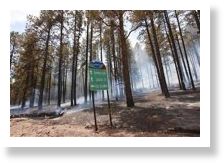
© ReutersCharred forest smolders from the Las Conchas Fire near Los Alamos, New Mexico.
Santa Fe - As firefighters made progress saving Indian pueblo lands on the north end of New Mexico's largest wildfire, officials worried on Monday about a possible second punch from Mother Nature -- flash floods.
The fast-burning Las Conchas fire exploded on the scene a week ago, triggering the temporary evacuation of the Los Alamos nuclear laboratory. It has since charred more than 123,500 acres, the biggest torching of the state's lands in history.
But forecasters say seasonal rains are finally showing up across the tinder-dry Southwest, moving toward New Mexico.
"We've gone straight from fire danger to flood danger, so it's one thing after another," said a frustrated Jason Lott, superintendent of the Bandelier National Monument, a revered ancestral home of New Mexico's pueblo Indian natives.
Lott said more than 50 percent of the park, which consists of a total of 33,750 acres, has already been scorched by the Las Conchas blaze, although the visitors center, historic lodge and the ancient Tyounyi Pueblo ruins have been spared.
Those same structures, however, may now be threatened by flash floods expected with the state's monsoon season.
"It could be tomorrow, or in a couple weeks," Lott said.
The risk to flooding has been aggravated by the raging wildfire which has burned off trees, ground-hugging grasses and vegetation, raising concerns that any run-off will barrel down canyons unchecked, causing creeks to burst their banks.
Crews at Bandelier began working on Monday to clear stream beds, removing logs and other debris creating a clearer path so waters cannot back up and flood historic sites and buildings.
Many buildings will be sandbagged and hopefully sealed from the waters, Lott said.
On the Santa Clara Indian reservation, a few miles north of Los Alamos, easterly winds gave firefighters a temporary break as they battled to block the blaze's march toward the pueblo village of about 3,800 people, said tribal spokesman Joe Baca.
"The Forest Service along with the tribal government has established a pretty good fire line on the eastern area of the fire," Baca said, adding that the line is "holding and is turning the fire back on itself."
Baca said about 14,400 acres had been scorched. It had not destroyed any pueblo structures, but because of dense smoke and lack of access it was difficult to determine what if any cultural sites remain in peril on the 55,000-acre reservation.
Meanwhile, forestry and police investigators said they have determined the origin of the mammoth Las Conchas blaze.
It was ignited on June 26 when strong winds tipped an aspen tree onto nearby power lines in the Santa Fe National Forest about 12 miles southwest of Los Alamos.
State forester Tony Delfin said the power line arced, setting fire to the tree, which in turn fell to the ground and set the initial fires to surrounding vegetation. The tinder box bone-dry brush and high winds did the rest.
In Los Alamos, which had been threatened by the fire for about a week, residents on Monday continued returning to their homes after a forced evacuation to escape the flames.
The Los Alamos National Laboratory, birthplace of the atomic bomb, was expected to reopen on Wednesday.
To the south, residents in Sandoval County along the Cochiti Mesa will be returned to their homes and properties in government vehicles on Tuesday.
As of Monday, the Las Conchas fire had destroyed 63 homes, five commercial properties and 32 outbuildings, according to figures from the blaze's combined information center.
Four firefighters have been injured. None of the injuries are believed to be life-threatening, authorities said.
Reader Comments
to our Newsletter